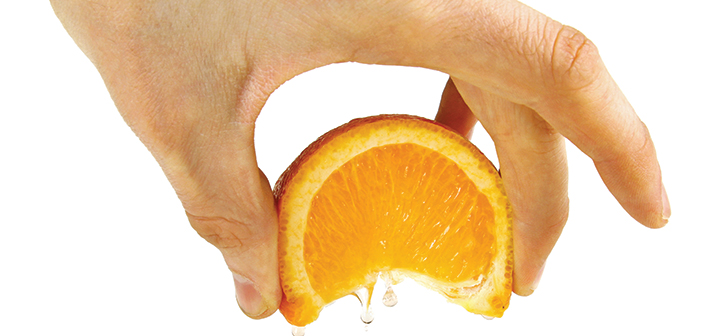We opened our Kerfoot Canopy Tour in 2013 without a refined decision-making process. Like many entrepreneurs, we had (and have) an abundance of ideas, but a finite cap on our time and money. So, with the advantage of experience, my decision-making mantra has become, “Is this worth my invested time and money?” Or, more colorfully, “Is the juice worth the squeeze?”
When analyzing this balance, we assign business demands into three main categories: physical structures, guests, and strategy/business. By sharing some of the decisions we have made, we hope to help you develop your own perfect “juice/squeeze” blend.
PHYSICAL STRUCTURES
Courses are priority #1. Back in 2013, we had an excess of ideas and limitations on starting capital. We asked ourselves, what would give the guests the best canopy tour experience? Our answer: the tour itself. An architectural masterpiece of a check-in building would have been nice, but without fabulous zip lines, incredible towers, and beautiful scenery, our tour would be nothing.
So, instead of balancing our starting funds to build an okay check-in center and an okay canopy tour, we built a huge, 14-zip canopy tour with fabulous views and professional construction, and kept our registration building simple. The juice wasn’t worth the squeeze to spend hundreds of thousands of dollars on a building versus investing that capital into our main event.
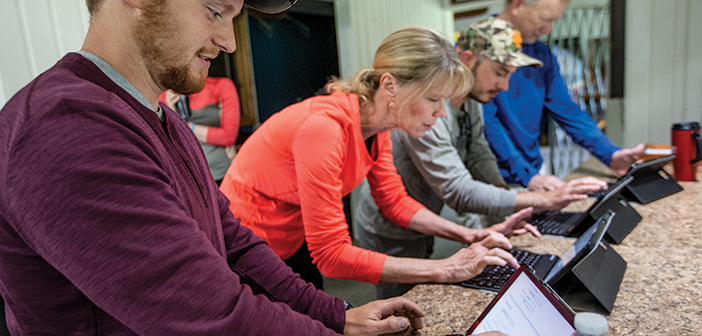
Kerfoot’s spartan registration center gets the job done.
Our registration center cost $29,000. We used recycled telephone poles to construct an attractive and well-themed 420-square-foot structure. We leveled the land and decked it in ourselves. The building houses our registration, gift store, guide break room, and manager’s office. Although snug and far from technically perfect, it operates efficiently and meets our needs.
Guest comfort considerations. We didn’t want our scale to be too out of balance, so we needed attractive areas for guests to use. We built several covered picnic table areas to provide relief from the sun. All of our gear-up areas have hard roofs. We have fans and heaters under the roof of our canopy tour gear-up deck to keep guests comfortable throughout the season.
For our guest bathrooms, we chose to use porta-potties. That might make you cringe. However, we did not think bathrooms were going to make a major difference to the guest experience or drive reservations. To make the porta-potties as nice as possible, we installed spacious accessible units and clean them several times a week. We still believe that the juice of classy bathrooms was not worth the squeeze it would have placed on our bank account.
That view may change, of course. We re-evaluate our decisions all the time, and think every day about how our time and money are invested.
Litter-free zone. I was raised on a family resort. My father, Bruce, insisted we had to be neat and provide “clean dirt” for guests. That meant picking up litter constantly. The absence of litter allows guests to appreciate the beauty of their surroundings; Bruce saw this as part of running a professional business.
To this day, even when I’m jammed with tasks, I still make time to scour the parking lot picking up litter. If this means that I have an additional hour of payroll a week in order to make time for employees to do litter pick-up, I am good with it. The juice is most definitely worth the squeeze to have litter-free property.

Clean, litter-free grounds allow guests to appreciate the outdoors.
Kayak rentals. With our location next to the Minnesota River, I thought we should add kayak rentals to grow business. We made a sizable investment in all of the necessary gear, including kayaks, life jackets, paddles, a van, and a trailer. I was ready to enjoy the juice!
After year one, kayak revenue was $5,000; after year two, $25,000. Despite the impressive growth, the expansion wasn’t working. Kayak rentals required employee hours that we did not have. The put-ins and take-outs to the river were muddy, and the river water was as dark as chocolate milk. Guests were miserable when they fell into the water or had to walk through calf-deep, sludgy mud. None of our staff wanted to be part of this experience. The juice was definitely not worth the squeeze, so we pulled the plug and sold everything, at a significant loss.
Ball track. In 2020, we developed a new “juice,” a wooden ball track that weaves through the forest. This new activity welcomes younger guests, and at a tiny variable cost. However, the initial construction costs were higher, and it’s projected to generate only $5,000 (in a good year). I am still weighing my scale on this one.
Shorter tour. Our course was built to be a 14-zip experience. That size demands a certain price. To offer a lower-priced experience, we looked at siphoning off a portion of the course and calling it its own experience. The shorter tour included the first eight zip lines on the 14-line tour. Offering a shorter course allowed us to host more guests, but also increased our variable payroll costs.
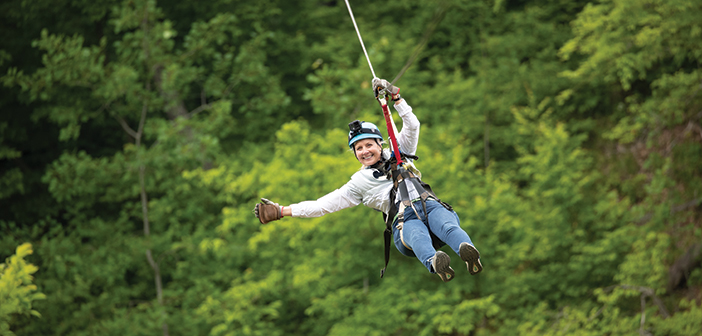
The 14-line zip tour at Kerfoot delivers an awesome experience.
While this seemed like a can’t-fail idea, the shorter experience was not as great as we wanted it to be. Our 14-zip experience is the sort of thing author Seth Godin terms a “purple cow”—something that stands out as amazingly different while elevating the experience or service. Our eight-zip tour didn’t. That juice was not worth the squeeze, so we removed it from our website and will only offer it in special situations.
GUESTS
We believe there are two guests in every business: Internal guests are the employees who deliver the experience, and external guests are those who pay for the experience.
Service and a commitment to excellence are essential for all of these guests. These factors directly impact the experience for the external guests and the morale of internal guests. As a scrappy start-up, we wanted to convert as many guests as possible into advocates. So the juice was worth the squeeze to focus on delivering amazing guest service.
Commitment to the details. For us, taking care of the external guests and doing the little things is extremely important. We expect our guides to: 1) learn and use guest names; 2) organize our gloves and hand them to guests, so they don’t have to dig through a pile of gloves themselves; 3) get water for the guests vs. saying “go help yourself;” and 4) never joke about safety or use sarcasm with the guests. All of these are a critical part of the experience we want to deliver, and the juice is most definitely worth the squeeze.
Service recovery. Properly handling unhappy guests after service failures is a critical issue. Service recovery is essentially how you respond to a service mistake or unmet guest expectation.
Guests want to be treated fairly, and when we blow them away with service, compassion, and empathy, they become advocates on our behalf. Research shows that this happens even if you have made a big mistake that led to a bad experience—IF you nail the service recovery. This has heavily influenced how we handle the inevitable mistakes that happen.
When we don’t deliver the expected service (it happens), we try to deliver a stellar service recovery. An awesome service recovery magically transforms complaining guests into happy advocates telling everyone how awesome you are. Then we thoroughly train to prevent the problem from happening again. As long as we do not keep repeating the same mistakes, for us, the juice is worth the squeeze to blow guests away with service.
GoPro rentals provide a good example. When mistakes happen with the video, guests always tell us we have ruined their experience. For our service recovery, we do not simply refund the cost of the GoPro—we give a free gift certificate for the guest to come back a second time on us. This transforms guests from being aggressive and complaining to amazed and appreciative. Often they return with paying friends, which in effect converts their free tour to a buy-one-get-one deal. For us, the juice is worth the squeeze to nail the service recovery and have as many advocates as possible.
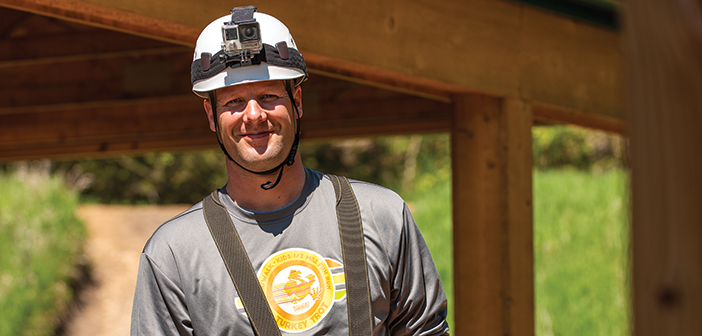
When GoPro rentals go bad, service recovery is essential—and worth the cost.
STRATEGY/BUSINESS
Hiring managers vs. self-managing. An early decision entrepreneurs face is, do you run the day-to day operations yourself or hire a manager? When we opened our tour, I had a day job and my wife was raising our two kids. For the first two years we were at the tour every night and weekend to ensure our culture and vision were being implemented. We believed this was critical and would help us to better grow the business.
After two seasons we asked ourselves two questions: 1) Did we want to keep running the tour, or did we want to hire a general manager? 2) If we hired a GM, did we want the position to be year-around or seasonal? At that time, and still to this day, 90 percent of our income is made during the peak six-month summer season.
From a strategy perspective, hiring a manager to run the business allowed us to work “on” the business and not “in” the business. That meant we could focus on improving systems, processes, or standards to make the business work better, and not managing the day-to-day tasks. We felt that the continuity of a great manager, the culture, and the systems was important then, and we still feel that way today. So the juice was worth the squeeze to hire a great general manager.
That meant it was worth the squeeze to take the time and ensure we nailed the hire. I increased my odds by strictly following the process outlined in the book Who: The A Method for Hiring, by Geoff Smart and Randy Street, which helped immensely.
Debt vs. pay-as-you-go financing. One area we differ from my father is debt. He liked to expand using debt. We like to pay cash to expand.
All entrepreneurs face this trade-off. It’s often a question of rapid expansion vs. slower growth. I make too many mistakes to afford taking on significant debt to build new adventures. For us, the juice is not worth the squeeze to take on debt (and risk) to expand rapidly.
Expanding slowly has a few advantages. First, we are not taking on additional debt and the associated stress. Second, we build a little, learn what works, then apply the lessons as we grow. Third, we offer new adventures for our guests every year, giving them a reason to come back. Fourth, this continues to increase cash flow. Most importantly, if we build something that does not work out (or if a pandemic forces us to shut down), we can close it down without the associated liabilities of a large bank loan.
Marketing. As we migrated to working “on” the business, one area we focused on was marketing. We knew enough about pay-per-click marketing to spend the budget, but we struggled to calculate a return on our ad spend for each digital ad. We were wasting marketing money by not analyzing the data. Ugh! The task was daunting and rapidly evolving—it felt like trying to learn another language by lip reading.
The juice was definitely worth the squeeze to hire a professional marketing agency. We remained committed to this path even though it took several seasons to find an agency that understood both the outdoor recreation business and our booking engine.
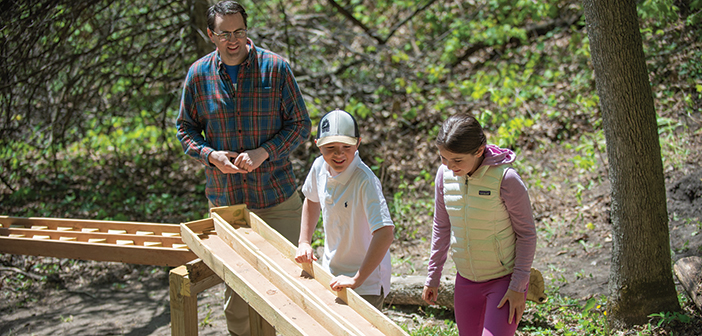
The ball track keeps young kids entertained, but the juice-to-squeeze ratio is still TBD.
How much marketing help? Since 90 percent of our income comes in May through October, the juice was not worth the squeeze to have a marketing agency engaged year-round. But what was the right fit?
We use a marketing agency for seven months—April through August, plus November and December. For summer 2020, we skipped the fall months, with the hope that we would be able to fill the tour without needing to run pay-per-click marketing. We brought back the agency for November and December to run a holiday gift certificate sale that brings in approximately $90,000 in sales. The gift certificate sale is driven extensively by pay-per-click advertising, retargeting, and online profile marketing. The juice was worth the squeeze to keep the marketing agency on retainer to help with the sale.
Billboards. We have gone back and forth on billboards. Our Kerfoot tour is about 45 minutes outside of Minneapolis, and not in a huge drive-to destination. So, when we opened in 2013, we sparingly used billboards. It didn’t seem there was enough juice to be had from billboards.

Billboards, such as this one for Kerfoot’s newer Brainerd, Minn., tour, failed to drive business for the original tour 45 minutes outside of Minneapolis.
Over time we increased our use of them. By 2019, we thought billboards were really driving business, and spent $50,000 in billboard advertising to increase visits. Alas, our business was flat to the prior year. Since billboards are expensive and did not appear to have a corresponding impact, we decided they were not worth the financial squeeze.
Tracking ad efficiency. As we work “on” marketing, we try to focus on things that will make the biggest difference. For example, we believe strongly in trying to track the return on ad spend for everything we do. But if all that tracking is not resulting in significant efficiencies, then is the juice worth the squeeze? If the return on ad spend for Waze is amazing, but only generates a few reservations a month, is this worth the squeeze? As we try to manage our limited time and precious funds, our answer is no.
Gift store strategy. At the end of each year we spend time analyzing what shirts and hats are and are not selling. Typically, one in four will be a good seller. So we are stuck with three poor-selling hats/shirts for every one that sells quickly. Inevitably, we do not reorder the best-sellers quickly enough, and end up with shelves full of the poor-selling merchandise. That really bothers me.

The gift shop, located in the small check-in building, needs to justify the space it occupies. Inventory is constantly adjusted to remove slow-selling items.
We have a small gift store, so every inch of space is extremely valuable. We do everything we can to get poor-selling gear out of the store as quickly as possible, even selling it at cost, so we can replace it with items that will sell better. For us, getting rid of the bad-selling inventory (at nearly any price) is worth the juice if we can replace it with a good- to great-selling item.
Knowing ourselves and our values helps us decide which opportunities—the juice—are worth our money, time, and energy—the squeeze. We hope you, too, can find the juice that’s worth the squeeze. Have a great 2021 season!


